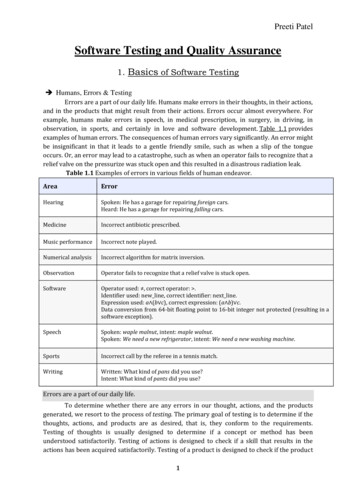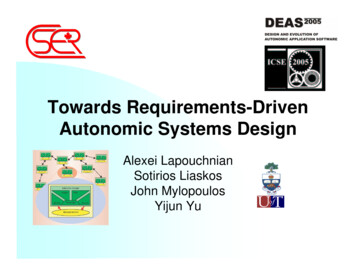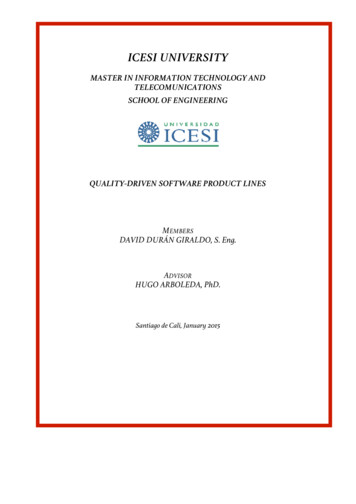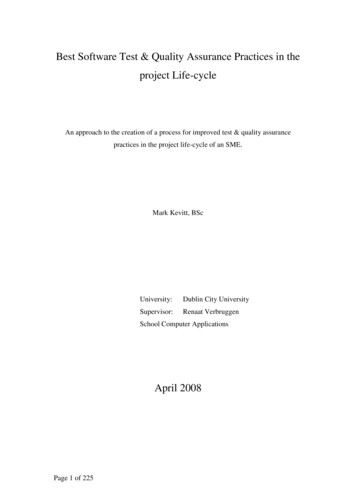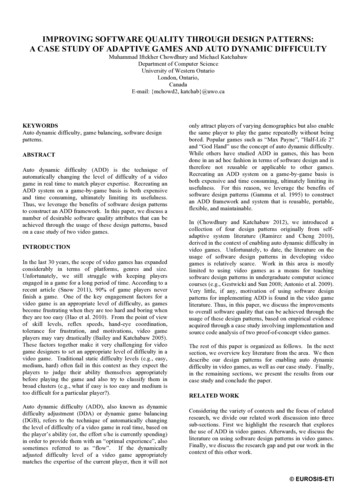
Transcription
IMPROVING SOFTWARE QUALITY THROUGH DESIGN PATTERNS:A CASE STUDY OF ADAPTIVE GAMES AND AUTO DYNAMIC DIFFICULTYMuhammad Iftekher Chowdhury and Michael KatchabawDepartment of Computer ScienceUniversity of Western OntarioLondon, Ontario,CanadaE-mail: {mchowd2, katchab}@uwo.caKEYWORDSAuto dynamic difficulty, game balancing, software designpatterns.ABSTRACTAuto dynamic difficulty (ADD) is the technique ofautomatically changing the level of difficulty of a videogame in real time to match player expertise. Recreating anADD system on a game-by-game basis is both expensiveand time consuming, ultimately limiting its usefulness.Thus, we leverage the benefits of software design patternsto construct an ADD framework. In this paper, we discuss anumber of desirable software quality attributes that can beachieved through the usage of these design patterns, basedon a case study of two video games.INTRODUCTIONIn the last 30 years, the scope of video games has expandedconsiderably in terms of platforms, genres and size.Unfortunately, we still struggle with keeping playersengaged in a game for a long period of time. According to arecent article (Snow 2011), 90% of game players neverfinish a game. One of the key engagement factors for avideo game is an appropriate level of difficulty, as gamesbecome frustrating when they are too hard and boring whenthey are too easy (Hao et al. 2010). From the point of viewof skill levels, reflex speeds, hand-eye coordination,tolerance for frustration, and motivations, video gameplayers may vary drastically (Bailey and Katchabaw 2005).These factors together make it very challenging for videogame designers to set an appropriate level of difficulty in avideo game. Traditional static difficulty levels (e.g., easy,medium, hard) often fail in this context as they expect theplayers to judge their ability themselves appropriatelybefore playing the game and also try to classify them inbroad clusters (e.g., what if easy is too easy and medium istoo difficult for a particular player?).Auto dynamic difficulty (ADD), also known as dynamicdifficulty adjustment (DDA) or dynamic game balancing(DGB), refers to the technique of automatically changingthe level of difficulty of a video game in real time, based onthe player’s ability (or, the effort s/he is currently spending)in order to provide them with an “optimal experience”, alsosometimes referred to as “flow”. If the dynamicallyadjusted difficulty level of a video game appropriatelymatches the expertise of the current player, then it will notonly attract players of varying demographics but also enablethe same player to play the game repeatedly without beingbored. Popular games such as “Max Payne”, "Half-Life 2"and “God Hand” use the concept of auto dynamic difficulty.While others have studied ADD in games, this has beendone in an ad hoc fashion in terms of software design and istherefore not reusable or applicable to other games.Recreating an ADD system on a game-by-game basis isboth expensive and time consuming, ultimately limiting itsusefulness. For this reason, we leverage the benefits ofsoftware design patterns (Gamma et al. 1995) to constructan ADD framework and system that is reusable, portable,flexible, and maintainable.In (Chowdhury and Katchabaw 2012), we introduced acollection of four design patterns originally from selfadaptive system literature (Ramirez and Cheng 2010),derived in the context of enabling auto dynamic difficulty invideo games. Unfortunately, to date, the literature on theusage of software design patterns in developing videogames is relatively scarce. Work in this area is mostlylimited to using video games as a means for teachingsoftware design patterns in undergraduate computer sciencecourses (e.g., Gestwicki and Sun 2008; Antonio et al. 2009).Very little, if any, motivation of using software designpatterns for implementing ADD is found in the video gameliterature. Thus, in this paper, we discuss the improvementsto overall software quality that can be achieved through theusage of these design patterns, based on empirical evidenceacquired through a case study involving implementation andsource code analysis of two proof-of-concept video games.The rest of this paper is organized as follows. In the nextsection, we overview key literature from the area. We thendescribe our design patterns for enabling auto dynamicdifficulty in video games, as well as our case study. Finally,in the remaining sections, we present the results from ourcase study and conclude the paper.RELATED WORKConsidering the variety of contexts and the focus of relatedresearch, we divide our related work discussion into threesub-sections. First we highlight the research that exploresthe use of ADD in video games. Afterwards, we discuss theliterature on using software design patterns in video games.Finally, we discuss the research gap and put our work in thecontext of this other work. EUROSIS-ETI
Auto Dynamic DifficultyIn recent years, ADD has received notable attention fromnumerous researchers. Some of this research is primarilyfocused on knowledge seeking, whereas other works presentsolutions such as frameworks and algorithms. Additionally,in some research, new solutions are presented together withempirical validations. Here, we review some of these works.(Bailey and Katchabaw 2005) developed an experimentaltestbed based on Epic’s Unreal engine that can be used toimplement and study ADD in games. It allows developmentof new ADD algorithms as well. A number of mini-gamegameplay scenarios were developed in the test-bed andthese were used in preliminary validation experiments.(Rani et al. 2005) suggested a method to use real timefeedback, by measuring the anxiety level of the player usingwearable biofeedback sensors, to modify game difficulty.They conducted an experiment on a Pong-like game toshow that physiological feedback based difficulty levelswere more effective than performance feedback to providean appropriate level of challenge. Physiological signals datawere collected from 15 participants each spending 6 hoursin cognitive tasks (i.e., anagram and Pong tasks) and thesewere analyzed offline to train the system.(Hunicke 2005) used a probabilistic model to design ADDin an experimental first person shooter (FPS) game based onthe Half-life SDK. They used the game in an experiment on20 subjects and found that ADD increased the player’sperformance (i.e., the mean number of deaths decreasedfrom 6.4 to 4 in the first 15 minutes of play) and the playersdid not notice the adjustments.(Orvis et al. 2008), from an experiment involving 26participants, found that across all difficulty levels,completion of the game resulted in an improvement inperformance and motivation. Prior gaming experience wasfound to be an important influence factor. Their findingssuggested that for inexperienced gamers, the method ofmanipulating difficulty level would influence performance.(Hao et al. 2010) proposed a Monte-Carlo Tree Search(MCTS) based algorithm for ADD to generate intelligenceof non player characters. Because of the computationalintensiveness of the approach, they also provided analternative based on artificial neural networks (ANN)created from the MCTS. They also tested the feasibility oftheir approach using Pac-Man.(Hocine and Gouaïch 2011) described an ADD approach forpointing tasks in therapeutic games. They introduced amotivation model based on job satisfaction and activationtheory to adapt the task difficulty. They also conductedpreliminary validation through a control experiment oneight healthy participants using a Wii balance board game.Software Design Patterns in Video GamesIn a number of works, video games have been proposed as atool to teach software engineering in general and designpatterns in particular. On the other hand, unfortunately,work focusing on how game developers can benefit fromthe usage of software design patterns is relatively rare. Herewe discuss examples of both types of research.(Gestwicki and Sun 2008) presented a video game basedapproach to teach software design patterns to computerscience students. They developed an arcade style game,EEClone, which consists of six key design patterns and thenused these patterns in their case study. Student participantsanalyzed the game to learn the usage of those patterns.(Antonio et al. 2009) described their experience in teachingsoftware design patterns using a number of incrementalabstract strategy game design assignments. In theirapproach, each assignment was completed by refactoringand using design patterns on previous assignments.(Narsoo et al. 2009) described the usage of software designpatterns to implement a single player Sudoku game for theJ2ME platform. They found that through the use of designpatterns, new requirements could be accommodated bymaking changes to fewer classes than otherwise possible.Research GapAs we can see from above discussion, the work on ADD invideo games focuses on tool building (e.g., framework(Bailey and Katchabaw 2005), algorithm (Hunicke 2005;Hao et al. 2010) etc.) and empirical studies (e.g., Rani et al.2005; Orvis et al. 2008 etc.), but they all use an ad-hocapproach from a software design point view. On the otherhand, research on using software design patterns in videogames is mostly limited to using video games as a meansfor teaching design patterns in undergraduate computerscience courses (e.g., Gestwicki and Sun 2008; Antonio etal. 2009). In contrast, much work has been done towardsgame design patterns, such as the foundational work of(Björk and Holopainen 2004) and many others, but thefocus there is game design and not software design, whichis a subtle, yet important distinction. Thus, in this paper, wediscuss the software quality attributes that can be achievedthrough the usage of software design patterns in the contextof ADD, based on an empirical study.DESIGN PATTERNSIn this section, we briefly discuss the four software designpatterns for enabling ADD in video games. For furtherdetails, the reader is encouraged to refer to (Chowdhury andKatchabaw 2012) for elaborated discussion and examples.Sensor FactoryThe sensor factory pattern is used to provide a systematicway of collecting data while satisfying resource constraints,and provide those data to the rest of the ADD system.Sensor (please see Figure 1) is an abstract class thatencapsulates the periodical collection and notificationmechanism. A concrete sensor realizes the Sensor anddefines specific data collection and calculation. TheSensorFactory class uses the “factory method” pattern to EUROSIS-ETI
provide a unified way of creating any sensors. It takes thesensorName and the object to be monitored as input andcreates the sensor. Before creating a sensor, theSensorFactory checks in the Registry data structure to seewhether the sensor has already been created. If created, theSensorFactory just returns that sensor instead of creating anew one. Otherwise, it verifies with a ResourceManagerwhether a new sensor can be created without violating anyresource constraints.sequence they were raised in, the TriggerPool should be aFIFO data structure. The FixedRules data structure shouldsupport search functionality so that when theInferenceEngine takes a Trigger from the TriggerPool, itcan scan through the Rules held by FixedRules and find aDecision that appropriately responds to the Trigger.Figure 3: Case Based Reasoning Design PatternFigure 1: Sensor Factory Design PatternAdaptation DetectorWith the help of the sensor factory pattern, theAdaptationDetector (please see Figure 2) deploys a numberof sensors in the game and attaches observers to eachsensor. Observer encapsulates the data collected fromsensor, the unit of data (i.e., the degree of precisionnecessary for each particular type of sensor data), andwhether the data is up-to-date or not. AdaptationDetectorperiodically compares the updated values found fromObservers with specific Threshold values with the help ofthe ThresholdAnalyzer. Each Threshold contains one ormore boundary values as well as the type of the boundary(e.g., less than, greater than, not equal to, etc.). Once theThresholdAnalyzer indicates a situation when adaptationmight be needed, the AdaptationDetector creates a Triggerwith the information that the rest of the ADD process needs.Figure 2: Adaptation Detector Design PatternGame ReconfigurationOnce the ADD system detects that a difficulty adjustment isnecessary, and decides what and how to adjust the variousgame components, it is the task of the game reconfigurationpattern to facilitate smooth execution of the decision. TheAdaptationDriver receives a Decision selected by theInferenceEngine (please see case based reasoning in previoussection) and executes it with the help of the Driver. Driverimplements the algorithm to make any attribute change in anobject that implements the State interface (i.e., that the objectcan be in ACTIVE, BEING ACTIVE, BEING INACTIVE orINACTIVE states, and outside objects can request statechanges). As the name suggests, in the active state, the objectshows its usual behavior whereas in the inactive state, theobject stops its regular tasks and is open to changes. TheDriver takes the object to be reconfigured (default object usedif not specified), the attribute path (i.e., the attribute that needsto be changed, specified according to a predefined protocolsuch as object oriented dot notation) and the changed attributevalue as inputs. The Driver requests the object that needs to bereconfigured to be inactive and waits for the inactivation.When the object becomes inactive, it reconfigures the object asspecified. After that, it requests the object to be active andinforms the AdaptationDriver when the object becomes active.The GameState maintains a RequestBuffer data structure totemporarily store the inputs received during the inactive stateof the game. (If the reconfiguration is done efficiently,however, it should be completed within a single tick of themain game loop, and this buffering should be largelyunnecessary.) The GameState overrides Game’s event handlingmethods and game loop to implement the State interface.Case Based ReasoningWhile the adaptation detector determines the situation whena difficulty adjustment is required by creating a Trigger,case based reasoning (please see Figure 3) formulates theDecision that contains the adjustment plan. TheInferenceEngine has two data structures: the TriggerPooland the FixedRules. FixedRules contains a number of Rules.Each Rule is a combination of a Trigger and a Decision.The Triggers created by the adaptation detector will bestored in the TriggerPool. To address the triggers in theFigure 4: Game Reconfiguration Design Pattern EUROSIS-ETI
Integration of ADD Design PatternsIn this Section, we briefly re-discuss how the four designpatterns discussed in previous sub-sections work together tocreate a complete ADD system (please see Figure 5). Thesensor factory pattern uses Sensors to collect data from thegame so that the player’s perceived level of difficulty can bemeasured. The adaptation detector pattern observes Sensordata using Observers. When the adaptation detector findssituations where difficulty needs to be adjusted, it createsTriggers with appropriate additional information. Casebased reasoning gets notified about required adjustments bymeans of Triggers. It finds appropriate Decisions associatedwith the Triggers and passes them to the adaptation driver.The adaptation driver applies the changes specified by eachDecision to the game, to adjust the difficulty of the gameappropriately, with the help of the Driver. The adaptationdriver also makes sure that the change process is transparentto the player. In this way, all four design patterns worktogether to create a complete ADD system for a particulargame.will go back to the center of the maze and will stay there fora certain amount of time. Eating pellets gives points to PacMan. The player tries to eat all the pellets in the mazewithout losing all of Pac-Man’s lives. The player ismotivated to chase the ghosts while in predator mode, asthat will help them by removing the ghosts from the mazefor a time, allowing Pac-Man to eat pellets more freely.Ghosts only change direction when they reach intersectionsin the maze, while Pac-Man can change direction at anytime. A ghost’s vision is limited to a certain number of cellsin the maze. Ghosts chase the player if they can see them. Ifthe ghosts do not see Pac-Man, they try to roam the cellswith pellets, as Pac-Man needs to eventually visit thoseareas to collect the pellets. If the ghosts do not see eitherPac-Man or pellets, they move in a random fashion.Figure 5: Four Design Patterns Working Together in aGameCASE STUDYIn this section, we describe the case study used to assesssoftware quality improvements achieved through our designpatterns for ADD. We begin with a brief description ofeach of the two games that were used in the case study. Wethen describe the case study methods and the quality metricsthat were collected from the case study.Case Study GamesWe used two arcade style single player games developed inJava for the case study. The first game is a variant of PacMan and will be referred to as Game-P from here onwards.Game-P was developed for the purposes of this research.The level structure and gameplay of the second game issimilar to the popular Super Mario game series and will bereferred to as Game-S from here onwards. Game-S is aslightly modified version of a platform game described in(Brackeen et al. 2004). In sub-sections below, we brieflydescribe the game logic and ADD logic of these two games.Game-PIn this game, the player controls Pac-Man in a maze (pleasesee Figure 6). There are pellets, power pellets, and 4 ghostsin the maze. Pac-Man has 6 lives. Usually, ghosts are in apredator mode and touching them will cause the loss of oneof Pac-Man’s lives. When Pac-Man eats a power-pellet, itbecomes the predator for a certain amount of time. WhenPac-Man is in this predator mode and eats a ghost, the ghostFigure 6: Screen Captured from Game-PUsually, a Pac-Man game is multi-level, but ourimplementation (i.e., Game-P) has only one level. Themaximum possible score is 300 in our case, so the playerwill try to achieve the score of 300 without losing all ofPac-Man’s lives. Our assumption is that if the player losesall lives (i.e., 6) before finishing the game, then the averagescore per life (i.e., total score / number of lives lost toachieve the score) would be less than 50 and the gamewould seem overly difficult to them. On the other hand, ifthe player finishes the game losing half of the lives or less,then the average score would be greater than or equal to100, and the game would seem too easy to them. Thus, inthis case, the ADD system monitors the average-score-perlife and changes game difficulty accordingly. It startsincreasing the game difficulty when the monitored value ismore than 50 and the game become most difficult when thevalue is more than 100. (Corresponding logic decreases thegame difficulty when the average-score-per-life is less than50.) The attributes of ghost speed, ghost vision length,duration of Pac-Man’s predator mode, and the amount oftime that a ghost stays in the centre of the maze after beingeaten by Pac-Man in predator mode are increased or EUROSIS-ETI
decreased to change the game difficulty. Each of theseattributes has lower and upper limits, so that the gameincludes the option of someone playing extremely well orextremely poorly.Game-SIn this game, the player controls the player character in aplatform world (please see Figure 7). There are three levels,each having different tile based maps. There are power upsand non-player characters (i.e., enemies) in each level.There are three different types of power ups: basic powerups, bonus power ups, and a goal power up. Basic powerups and bonus power ups give certain points to the player.In each level there is one goal power up that can be found atthe end of the level. The goal power up takes the playerfrom one level to another. There are two different types ofnon-player characters: ants and flies. Ants and flies movein one direction and change direction when blocked by theplatforms. The player character can run on and jump fromplatforms. When the player character jumps on (i.e.,collides from above) non-player characters, the non-playercharacter dies. If the player character collides with a nonplayer character in any other direction, then the playercharacter dies instead. The player character has 6 lives.When the player character dies, it loses one life and thegame restarts from the beginning of that level. The playercharacter and ants are affected by gravity; flies are onlyaffected by gravity when they die.but has more points to give the player a sense of progressand accomplishment. Similar to Game-P, modifications inGame-S have lower and upper limits, so that the gameincludes the option of someone playing extremely well orextremely poorly.Case Study MethodHere we briefly discuss the steps that were taken during thecourse of the case study. Firstly, Game-P was developedwithout our pattern-based ADD system. Our ADD systemwas then developed and integrated with Game-P. Thesource code for the ADD system was then refactored withinthe scope of the design patterns. We manually testedGame-P separately and with the ADD system. A playersimulation (i.e., a simple artificial intelligence playing thegame itself using heuristic functions) was also created totest the game. Game-S was then chosen for study as it usedthe same Java platform as Game-P, but substantiallydiffered in terms of gameplay, and was freely available andwell documented in a book (Brackeen et al. 2004). Twodefault maps accompanied Game-S originally. We createdone more default map ourselves, as well as two differentvariants of each map, as discussed earlier. There was noscoring mechanism in Game-S as originally written, so wedeveloped scoring logic ourselves. After this, we took thesource code of our ADD system used with Game-P andextended its abstract base classes (Sensor, and so on) toadapt the system for Game-S. We manually tested Game-Sseparately and with the ADD system. We then analyzedand compared the source code of the ADD systems ofGame-P and Game-S to assess software quality according toa few key software metrics, as discussed in the next subsection.Analysis Tool and MetricFigure 7: Screen Captured from Game-SIn this game, three map variants were created for each level.For a particular level, the same objects were placed in themap, but positioned slightly differently. One map variantwas the default version and other two were easier andharder versions of the default map. The ADD systemmonitors score-per-level and life-lost-per-level, and adaptsdifficulty accordingly. One possible adaptation is themodification of the speed of the non-player characters andtakes place during the game. Another adaptation is achange in level structure (i.e., loading a different version ofthe map) and takes place when the player character goes tothe next level or in the next loading of the same level (i.e.,when the player character dies). The modifications areminor and assumed to be transparent to the player, butaltogether alter the game difficulty. Apart from this, eachlevel is more difficult and lengthier than the previous level,During the development of the ADD system for Game-P,we realized that much of its source code would be reusableacross various games. During the extension of the ADDsystem for Game-S, we did not need to make modificationsto many of the classes from the system for Game-P. Toassess this quantitatively, we selected a metric and a tool.As a metric, we used Source Lines of Code (SLOC), as it isa widely accepted software metric and helps in estimatingthe development effort of a software product. For a tool, weused Unified Code Count (UCC) developed by theUniversity of Southern California Center for Systems andSoftware Engineering. Features of UCC include bothcounting SLOC and comparing two versions of source code.UCC counts both the logical and physical SLOC. As seenfrom the two examples in Table 1, since logical SLOCdisregards code formatting, it is more representative of thesize of the software, and so we used logical SLOC as ourmetric in this study.Table 1: Difference Between Physical and Logical SLOCExampleif(a 0) foo();if(a 0){foo();}Physical vs. Logical SLOCPhysical SLOC 1,Logical SLOC 2Physical SLOC 4,Logical SLOC 2 EUROSIS-ETI
SOFTWARE QUALITY ASPECTSIn this section, we describe how different desirable softwarequality attributes can be achieved through using the designpatterns described earlier in this paper. For this discussion,we refer to case study results and observations.ReusabilityReusability refers to the degree to which existingapplications can be reused in new applications. Reusabilityof source code reduces implementation time and increasesthe probability that prior testing has eliminated defects.In Table 2, we show our reusability analysis of the sourcecode of the ADD systems of Game-P and Game-S. In thefirst column, we show the class name or pattern name. Inthe next four columns we show information related toGame-P. In the first Game-P column we show the numberof classes in each category (i.e., specified in column 1). Inthe second column we show the corresponding total logicalSLOC in Game-P. In the third column we show thereusable Logical SLOC (i.e., code that remained unchangedin Game-S) and the associated percentage. In the fourthcolumn we show the game specific Logical SLOC (i.e.,specific to Game-P and cannot be reused) and the associatedpercentage. The remaining columns report similar data, thistime from the perspective of Game-S. For clarity, wecombined 100% reusable classes within a particular pattern.After all the rows of a particular pattern we show thesummary of that pattern. The last row of the table is thesummary across all the patterns.We can see from Table 2 that SensorFactory, Sensor,Registry and ResourceManager classes in the sensor factorydesign pattern are completely reusable. Similarly, classesrequired to implement the Observer, Trigger, Threshold andThresholdAnalyzer in the adaptation detector pattern arecompletely reusable. Three classes (i.e., Rule, FixedRulesand Decision) in the case based reasoning pattern, and threeclasses (i.e., Driver, AdaptationDriver and State) in thegame reconfiguration pattern are also completely reusable.Furthermore, the classes required to implementAdaptationDetector, InferenceEngine and GameState arepartially reusable. Only the concrete sensors (6 classes inGame-P and 3 classes in Game-S) and the concretedecisions (2 classes in Game-P and 5 classes in Game-S) arespecific to the game and not reusable.As we can see from the last row in Table 2, the ADDsystem in Game-P contains 27 classes comprised of 774logical SLOC. Similarly, the ADD system in Game-Scontains 753 logical SLOC in 27 classes. Between thesetwo systems, 600 logical SLOC (77.52% in Game-P;79.68% in Game-S) are exactly the same and thus areconsidered reusable. Only 174 (22.48%) logical SLOC inGame-P and 153 (20.32%) logical SLOC in Game-S arespecific to the games. Overall, more than three fourths(75%) of the logical SLOC required to implement the ADDsystems are considered reusable.IntegrabilityIntegrability refers to the ability to make the separatelydeveloped components of the system work correctlytogether. As we can see in Figure 5, the integration pointsamong the design patterns and with the game are clearlydefined. Observers, Triggers and Decisions are theintegration points between the four design patterns. Sensorsand Drivers are the integration points between a game andthe ADD system. Sensors function as accessors to the gamewhereas Drivers function as mutators to the game. Becauseof these clearly defined integration points, the four designpatterns can be integrated with each other and a gameeasily. One of the games in the case study (Game-S) wasalready developed without any prior consideration of thesedesign patterns or even any ADD system. Regardless, weeasily managed to extend and add our ADD system to thatgame using our design patterns, which demonstrates theintegrability of the patterns (and also Game-S).Table 2: Reusability Analysis of the Source Code of ADD Systems in Game-P and Game-SClass/ Pattern NameSensorFactory, Sensor,Registry, Resource ManagerConcreteSensorsSensor FactoryObserver, Trigger, ation DetectorRule, Decision, ed ReasoningDriver, AdaptationDriver,StateGameStateGame ReconfigurationGrand TotalGame-PGame-S# ofLogical SLOC# ofLogical SLOCClasses Total Reusable(%) Specific(%) Classes Total Reusable(%) Specific(%)4610218218(100)0(0)680(0)68(100)286 218(76.22) 68(23.78)519797(100)0(0)6821(30.88)47(69.12)6165 118(71.52) 7154 121(78.57) 33(21.43)314279999(100)0(0)7044(62.86)26(37.14)169 143(84.62) 26(15.38)774 600(77.52) 174(22.48)437218218(100)0(0)440 (0)44(100)262 218 (83.21) 44(16.79)519797(100)0(0)6521(32.31)44(67.69)6162 118(72.84) 0(100)10156 121(77.56) 35(22.44)314279999(100)0(0)7444(59.46)30(40.54)173 143(82.66) 30(17.34)753 600(79.68) 153(20.32) EUROSIS-ETI
PortabilityPortability is the ability of a system to run under differentcomputing environments. A framework- or middlewarebased approach for creating a self-adaptive system (such asADD in video games) is usually specific to a particularprogramming language and or platform, whereas a designpattern-based approach is highly portable across differentplatforms and programming languages (Ramirez and Cheng2010). These design patterns were derived from the selfadaptive system literature in the context of ADD in videogames. This indicates th
hand, research on using software design patterns in video games is mostly limited to using video games as a means for teaching design patterns in undergraduate computer science courses (e.g., Gestwicki and Sun 2008; Antonio et al. 2009). In contrast, much work has been done towards game design patterns, such as the foundational work of

